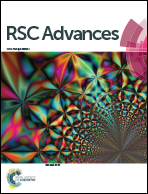Roles of DMSO-type ruthenium complexes in disaggregation of prion neuropeptide PrP106–126†
Abstract
Ruthenium complexes are potential anticancer metallodrugs and inhibitors of various proteins, such as enzymes and even amyloid peptides. Studies on Aβ protein, human islet amyloid polypeptide, and prion neuropeptide have indicated that Ru complexes can inhibit amyloidosis. However, the interaction mechanism of peptides with Ru complexes remains unclear. In this study, we selected four dimethyl sulfoxide (DMSO)-type Ru complexes containing large aromatic ligands to explore and compare the interactions of Ru complexes with the prion neuropeptide PrP106–126. Results showed that, unlike new anti-tumor metastasis inhibitor-A-like compounds, these complexes can bind to PrP106–126 mainly through metal coordination and hydrophobic interaction. The Ru complexes disaggregated the PrP106–126 fibrils into scattered fragments or amorphous forms, thereby reducing the toxicity of PrP106–126. Among the four Ru complexes, complex 1, which consists of bipyridyl and DMSO ligands, exhibited the highest disaggregation ability and relatively high cell viability, which may be attributed to its molecular configuration and low cytotoxicity. These results suggested that Ru complexes are promising metallodrugs against amyloidosis-related diseases.


 Please wait while we load your content...
Please wait while we load your content...